
The 30 best counties to live in Texas based on numerous factors including median home prices for mortgage insights
More counties in the United States experienced population growth in the last year, according to the latest Census data, even as pandemic-related moving trends begin to normalize.
Counties in the South continued to experience growth, particularly in Florida, where 96% of its 67 counties gained new residents. Polk County, Florida, a suburb of Orlando, added the most, with 26,000 people moving there in 2023.
Meanwhile, counties in the Midwest and Northeast continued to lose population, but at slower rates than the year before. Some of the biggest losses were in counties home to large cities, including Cook County, Illinois (home of Chicago) and the boroughs of Brooklyn and Queens in New York.
Many counties are experiencing growth due to their job opportunities, education, or relatively affordable housing costs. Others are favored for their historic or well-designed downtowns or access to cultural opportunities.
Stacker compiled a list of the best counties to live in Texas using rankings from Niche. Niche ranks counties by various factors including public schools, educational attainment, cost of living, and housing.
Keep reading to see if your county made the list.
You may also like: Where people in Texas are moving to most

#30. Erath County, Texas
– Overall Rank: 319
– Population: 42,788
– Median household income: $59,654
– Median home value: $219,600 (63% own)
– Median rent: $1,070 (37% rent)
– Top public schools: Dublin Elementary School (grade A), Henderson Junior High School (grade A), Hook Elementary School (grade A)
– Top private schools: Stephenville Christian School (grade unavailable), Silver Saddle Christian Academy (grade unavailable)
– Top places: Stephenville (grade A minus), Dublin (grade B+)

About
Erath County lies in Central Texas, where open prairies meet wooded hills and farmland stretches toward the horizon. Stephenville, the county seat, is widely recognized as the “Cowboy Capital of the World,” reflecting the area’s deep ranching traditions and rodeo culture. Agriculture, education, and small-town commerce have long formed the foundation of the county’s identity.
Community life is enriched through festivals, rodeo events, and gatherings that celebrate both Western heritage and local pride. Tarleton State University adds a vibrant educational presence, linking the county to broader opportunities while keeping roots firmly grounded. Erath County reflects a place where ranching legacy, community spirit, and steady growth remain woven together.
Where is Erath County?

Erath County is located in north-central Texas, bordered by Hood County to the northeast, Comanche County to the south, and Eastland County to the west. It lies about 70 miles southwest of Fort Worth and 100 miles northwest of Waco. The county covers part of the Cross Timbers region, with rolling prairies, wooded areas, and sections of the Paluxy and Bosque Rivers.
Stephenville, the county seat, is situated near the center and is home to Tarleton State University. Smaller communities include Dublin to the southwest and Morgan Mill to the north. With its mix of agriculture, education, and ranching traditions, Erath County serves as both a regional hub and a link between the Metroplex and central Texas.
#29. Bell County, Texas
– Overall Rank: 317
– Population: 372,821
– Median household income: $62,858
– Median home value: $196,300 (55% own)
– Median rent: $1,095 (45% rent)
– Top public schools: Holland Middle School (grade A), Lakewood Elementary School (grade A), Sparta Elementary School (grade A)
– Top private schools: Central Texas Christian School (grade A minus), Holy Trinity Catholic High School (grade A minus), Memorial Christian Academy (grade A minus)
– Top places: Morgan’s Point Resort (grade A), Harker Heights (grade A minus), Nolanville (grade A minus)

About
Bell County sits in Central Texas, where rolling prairies and the Balcones Escarpment shape both land and settlement. The county is anchored by Killeen, Temple, and Belton, communities tied to commerce, education, and the presence of Fort Cavazos, one of the nation’s largest military installations. Agriculture remains important, but military and healthcare institutions now play defining roles in the county’s identity.
Life here is active and diverse, with residents connected through school traditions, civic events, and regional festivals. Outdoor recreation at Stillhouse Hollow Lake and Belton Lake ties community life to the landscape. Bell County reflects a balance of rural heritage, modern growth, and the influence of both military and civic pride.
Where is Bell County?

Bell County is in central Texas, bordered by McLennan County to the north, Williamson County to the south, and Coryell County to the west. It lies about 60 miles north of Austin and 45 miles south of Waco, positioned along the I-35 corridor. The county’s geography includes rolling Blackland Prairie, sections of the Edwards Plateau, and the Leon River feeding into Belton Lake.
Belton, the county seat, is located near the geographic center along the Leon River. Temple, the largest city, sits to the northeast, while Killeen to the west is closely tied to Fort Cavazos (formerly Fort Hood). With its combination of military presence, medical facilities, and education centers, Bell County serves as a major hub of central Texas.
#28. Madison County, Texas
– Overall Rank: 298
– Population: 13,556
– Median household income: $65,768
– Median home value: $139,100 (71% own)
– Median rent: $814 (29% rent)
– Top public schools: Madisonville Intermediate School (grade A minus), Madisonville Junior High School (grade A minus), Madisonville High School (grade B+)
– Top private schools:
– Top places: Madisonville (grade A minus), Midway (grade B+)

About
Madison County rests in East-Central Texas, where prairies and woodlands meet along historic travel routes. Created in the mid-1800s, the county carries the name of President James Madison, reflecting its roots in early statehood and frontier life. Madisonville, the county seat, has long served as a hub for farming communities and small-town commerce.
Life here remains closely tied to agriculture, with cattle, poultry, and crop production forming a steady foundation. Community pride is celebrated through traditions like the annual Mushroom Festival, school events, and church gatherings. Madison County reflects a place where history, land, and community traditions remain firmly bound together.
Where is Madison County?
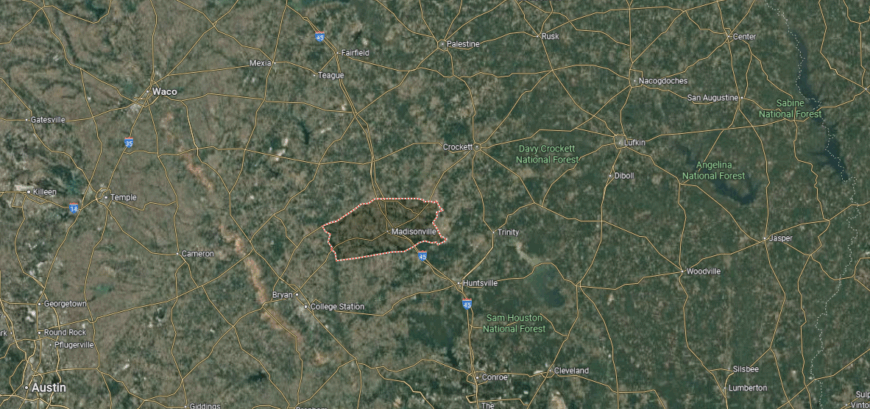
Madison County is located in east-central Texas, bordered by Leon County to the north, Walker County to the south, and Grimes County to the southeast. It sits about 35 miles northeast of Bryan–College Station and roughly 90 miles northwest of Houston. The county lies within the Post Oak Savannah region, with gently rolling prairies, woodlands, and the Trinity River forming part of its eastern boundary.
Madisonville, the county seat, is positioned near the center along Interstate 45 and serves as the primary hub of commerce and government. Smaller communities include Midway to the east and North Zulch in the western section. With its agricultural roots, highway access, and proximity to major urban centers, Madison County blends rural traditions with regional connectivity.
#27. Brazoria County, Texas
– Overall Rank: 294
– Population: 374,600
– Median household income: $91,972
– Median home value: $256,900 (74% own)
– Median rent: $1,333 (26% rent)
– Top public schools: Glenda Dawson High School (grade A+), Silvercrest Elementary School (grade A), Challenger Elementary School (grade A)
– Top private schools: Brazosport Christian School (grade B+), Angleton Christian School (grade B+), Living Stones Christian School (grade B minus)
– Top places: Pearland (grade A+), Lake Jackson (grade A), Manvel (grade A minus)

About
Brazoria County stretches along the Texas Gulf Coast, where rivers, prairies, and bays shape both its landscape and its story. One of Texas’s earliest Anglo-settled regions, it holds a deep connection to the state’s founding, from Stephen F. Austin’s colony to the early fight for independence. Today, its identity blends coastal beauty, history, and modern growth.
Life here flows between industry, agriculture, and recreation, with the Brazos River and Gulf waters offering both work and leisure. Residents celebrate heritage through historic sites, cultural festivals, and strong community traditions. Brazoria County reflects a place where coast, history, and community remain woven into daily rhythm.
Where is Brazoria County?

Brazoria County is in southeastern Texas, bordered by the Gulf of Mexico to the south, Galveston County to the east, and Fort Bend County to the northwest. It lies about 40 miles south of Houston and stretches from coastal marshlands to inland prairies along the Brazos River. The county’s geography includes barrier islands, bays, and fertile lowlands that have long supported farming and industry.
Angleton, the county seat, is near the center and anchors government functions. Other major communities include Lake Jackson, Alvin, Freeport, and Pearland, the latter of which connects directly into the Houston metropolitan area. With its mix of petrochemical industries, agriculture, and Gulf Coast access, Brazoria County is both an economic hub and a coastal gateway.
#26. Dallas County, Texas
– Overall Rank: 284
– Population: 2,604,053
– Median household income: $70,732
– Median home value: $252,200 (51% own)
– Median rent: $1,374 (49% rent)
– Top public schools: School for the Talented & Gifted (grade A+), School of Science & Engineering (grade A+), Coppell High School (grade A+)
– Top private schools: St. Mark’s School of Texas (grade A+), Greenhill School (grade A+), The Hockaday School (grade A+)
– Top places: Coppell (grade A+), University Park (grade A+), Sherrill Park North/Foxboro Addition (grade A+)
You may also like: Counties with the worst commutes in Texas

About
Dallas County anchors North Texas as one of the state’s most populous and economically dynamic regions. The city of Dallas serves as the county seat, driving commerce, technology, healthcare, and cultural life. Suburban communities surrounding the urban core reflect both rapid growth and deep local traditions.
Residents connect through major cultural events, professional sports, and neighborhood gatherings that highlight diversity and civic pride. The county blends global influence with strong community ties, offering both opportunity and rooted identity. Dallas County represents a place where modern growth and cultural vibrancy define its character.
Where is Dallas County?

Dallas County is located in north-central Texas, bordered by Collin County to the north, Ellis County to the south, and Tarrant County to the west. It lies at the heart of the Dallas–Fort Worth metroplex, about 35 miles east of Fort Worth and 195 miles north of Austin. The Trinity River flows through the county, shaping much of its lowland geography amid urban and suburban development.
Dallas, the county seat, is also the largest city and a major economic and cultural hub of Texas. Other cities within the county include Irving to the northwest, Garland to the northeast, and Mesquite to the east. With its extensive urban centers, transportation networks, and role in finance, technology, and commerce, Dallas County stands as one of the most dynamic regions in the state.
#25. Washington County, Texas
– Overall Rank: 281
– Population: 35,807
– Median household income: $70,043
– Median home value: $248,300 (73% own)
– Median rent: $1,025 (27% rent)
– Top public schools: Dripping Springs High School (grade A+), Burton Elementary School (grade A minus), Harper Middle School (grade A minus)
– Top private schools: First Baptist Church School (grade unavailable), St. Paul’s Christian Day School (grade unavailable), Citadel Christian School (grade unavailable)
– Top places: Brenham (grade A minus), Burton (grade B)

Washington County is often called the “Birthplace of Texas,” where delegates signed the Texas Declaration of Independence in 1836 at Washington-on-the-Brazos. Its landscape of rolling hills, farmland, and wildflowers frames a county deeply tied to both state history and rural tradition. Brenham, the county seat, reflects this balance with its civic role, cultural institutions, and strong community identity.
Residents celebrate heritage through museums, historic sites, and festivals that honor Texas’s beginnings. Agriculture remains central, with ranching and dairy production shaping the local economy, while tourism adds new vitality. Washington County stands as a place where history, land, and community pride remain inseparable.
Where is Washington County?
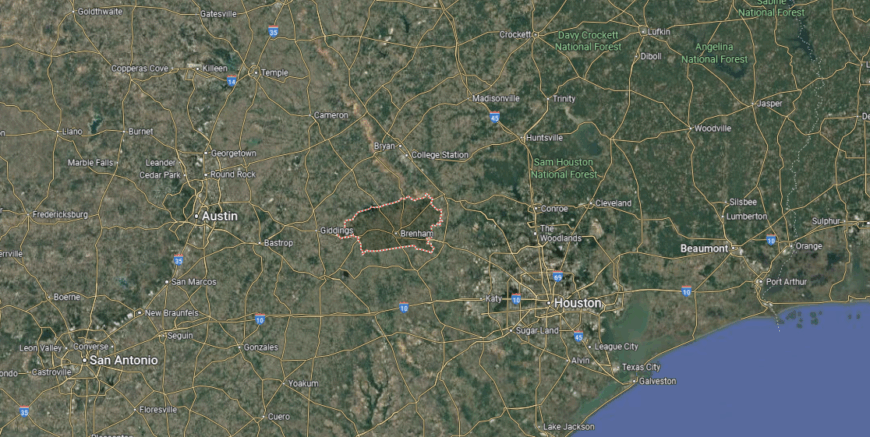
Washington County is in southeastern Texas, bordered by Burleson County to the west, Grimes County to the east, and Austin County to the south. It lies about 75 miles northwest of Houston and 80 miles east of Austin, within the rolling hills of the Post Oak Savannah and Blackland Prairie regions. The Brazos River forms part of its western boundary, adding to the county’s fertile landscape.
Brenham, the county seat, is located near the center and serves as the main hub of commerce and culture. Smaller communities include Chappell Hill to the east and Burton to the west, both known for their historic character. With its agricultural roots, historic landmarks, and ties to Texas’s independence, Washington County is often referred to as the “Birthplace of Texas.”
#24. Galveston County, Texas
– Overall Rank: 257
– Population: 350,801
– Median household income: $83,913
– Median home value: $260,600 (68% own)
– Median rent: $1,301 (32% rent)
– Top public schools: Friendswood High School (grade A+), Westwood Elementary School (grade A), Windsong Intermediate School (grade A)
– Top private schools: O’Connell College Preparatory School (grade A), Bay Area Christian School (grade B+), Trinity Episcopal School (grade unavailable)
– Top places: Friendswood (grade A+), League City (grade A+), Kemah (grade A)

About
Galveston County stretches along the Gulf of Mexico, where barrier islands, bays, and coastal plains define both scenery and way of life. Its history is marked by the port city of Galveston, once a major gateway to Texas and still a center of trade, tourism, and culture. The shoreline, with its shifting tides and open horizon, gives the county a character shaped by water and resilience.
Community life flows through beach festivals, maritime traditions, and cultural events that reflect both local pride and global influence. Residents balance coastal living with economic ties to Houston and the Gulf industries. Galveston County remains a place where sea, history, and community converge in daily rhythm.
Where is Galveston County?

Galveston County is located on the upper Texas Gulf Coast, bordered by Harris County to the northwest, Brazoria County to the southwest, and Chambers County to the northeast. It lies about 50 miles southeast of Houston and stretches across the mainland and barrier islands along Galveston Bay and the Gulf of Mexico. The county’s geography includes coastal prairies, marshlands, and sandy beaches.
Galveston, the county seat, sits on Galveston Island and is a historic port city with strong cultural and economic significance. Other communities include Texas City on the mainland, League City to the north, and Kemah along the bayfront. With its mix of tourism, shipping, and industry, Galveston County serves as both a coastal destination and a key part of the Houston metropolitan area.
#23. Smith County, Texas
– Overall Rank: 254
– Population: 234,667
– Median household income: $69,053
– Median home value: $201,400 (69% own)
– Median rent: $1,129 (31% rent)
– Top public schools: Stanton-Smith Elementary School (grade A), Lindale Junior High School (grade A), Gus Winston Cain Elementary School (grade A)
– Top private schools: The Brook Hill School (grade A+), Bishop Thomas K. Gorman Catholic School (grade A+), All Saints Episcopal School (grade A+)
– Top places: Bullard (grade A minus), Tyler (grade A minus), Hideaway (grade A minus)

About
Smith County sits in East Texas, with Tyler as its county seat and cultural hub. Known for its rose industry, healthcare centers, and higher education institutions, the county blends agricultural roots with modern growth. Its location at regional crossroads has long made it a center of commerce and connection.
Community life thrives through school traditions, festivals like the Texas Rose Festival, and gatherings that showcase local pride. Residents value both small-town ties and the opportunities that come from a strong regional economy. Smith County reflects a steady balance of heritage, community, and development.
Where is Smith County?

Smith County is in northeastern Texas, bordered by Wood County to the north, Cherokee County to the south, and Henderson County to the west. It lies about 100 miles east of Dallas and 90 miles west of Shreveport, Louisiana, positioned in the Piney Woods region. The terrain is characterized by rolling hills, forests, and numerous small lakes and creeks.
Tyler, the county seat, is centrally located and serves as a major regional hub for healthcare, education, and commerce. Other communities include Lindale to the north and Whitehouse to the south, both contributing to the county’s suburban and rural mix. With its blend of industry, agriculture, and cultural attractions, Smith County anchors the economy and identity of East Texas.
#22. Robertson County, Texas
– Overall Rank: 246
– Population: 16,912
– Median household income: $59,410
– Median home value: $156,800 (75% own)
– Median rent: $781 (25% rent)
– Top public schools: Franklin Middle School (grade A), Mumford Elementary School (grade A), Roland Reynolds Elementary School (grade A)
– Top private schools:
– Top places: Hearne (grade B minus), Franklin (grade A minus), Calvert (grade B+)

About
Robertson County lies in the Brazos Valley, one of the earliest settled regions of Texas during the Republic era. Its history is tied to farming, ranching, and the early migrations that carried settlers into the fertile lands of Central Texas. The county seat, Franklin, reflects this heritage through its courthouse square and small-town traditions.
Residents celebrate their roots through community fairs, church gatherings, and festivals that honor the county’s long agricultural story. Cotton, cattle, and crops remain part of the landscape, while new industries and regional growth add to the economy. Robertson County represents a place where history, land, and community pride remain firmly linked.
Where is Robertson County?

Robertson County is located in east-central Texas, bordered by Limestone County to the north, Brazos County to the south, and Leon County to the east. It lies about 30 miles north of Bryan–College Station and roughly 110 miles southeast of Waco. The county sits within the Brazos River Valley, with fertile farmland, rolling prairies, and sections of the Post Oak Savannah.
Franklin, the county seat, is near the center and serves as the administrative and commercial hub. Other communities include Hearne in the southern part and Calvert along State Highway 6, both historically tied to railroads and trade. With its agricultural base, small-town character, and proximity to Bryan–College Station, Robertson County reflects the rural heart of central Texas.
#21. Harris County, Texas
– Overall Rank: 245
– Population: 4,726,177
– Median household income: $70,789
– Median home value: $235,300 (55% own)
– Median rent: $1,269 (45% rent)
– Top public schools: Carnegie Vanguard High School (grade A+), Debakey H.S. for Health Prof (grade A+), Kinder High School for the Performing and Visual Arts (grade A+)
– Top private schools: St. John’s School (grade A+), The Awty International School (grade A+), The Village School (grade A+)
– Top places: Washington Avenue Coalition / Memorial Park (grade A+), Neartown – Montrose (grade A+), Memorial (grade A+)
You may also like: Best scenic drives in Texas

About
Harris County rises on the Texas Gulf Coast, where bayous and waterways thread through one of the most dynamic urban centers in the country. Houston anchors the county with its ports, skyscrapers, and cultural districts, but surrounding towns and neighborhoods also hold strong local identities. The mix of energy, medicine, and international commerce has made the county a gateway for opportunity.
Life here is fast-paced yet rooted in community, from neighborhood festivals to global celebrations that reflect the county’s diversity. Families find balance in parks, schools, and local traditions that endure even within a metropolitan setting. Harris County remains a place where global scale and everyday community continue to meet.
Where is Harris County?
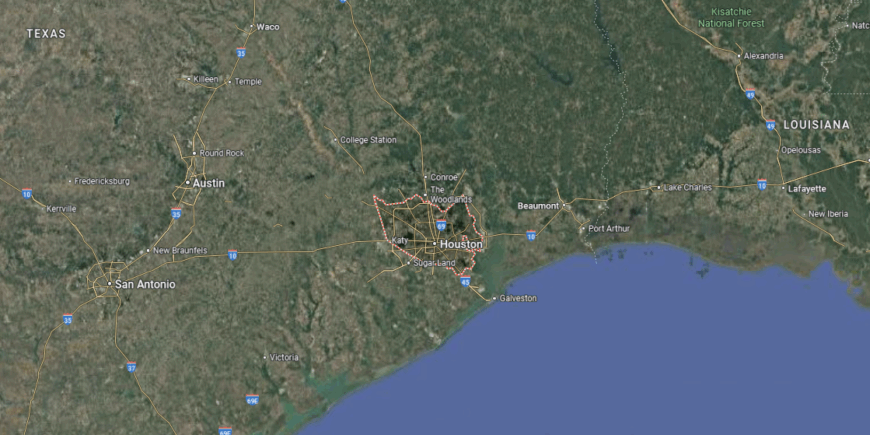
Harris County is in southeastern Texas, bordered by Montgomery County to the north, Fort Bend County to the southwest, and Chambers County to the east. It lies about 50 miles inland from the Gulf of Mexico and covers much of the Houston metropolitan area, the largest urban region in the state. The county’s geography includes coastal plains, bayous, and the lower reaches of the San Jacinto and Buffalo Bayou systems.
Houston, the county seat, is also the largest city in Texas and serves as a global hub for energy, commerce, and culture. Other communities include Pasadena to the southeast, Baytown along the Houston Ship Channel, and Cypress in the northwestern part of the county. With its massive population, economic diversity, and proximity to the Gulf, Harris County stands as one of the most influential regions in both Texas and the nation.
#20. Tom Green County, Texas
– Overall Rank: 238
– Population: 119,276
– Median household income: $67,215
– Median home value: $177,800 (67% own)
– Median rent: $1,024 (33% rent)
– Top public schools: Wall Middle School (grade A), Wall Elementary School (grade A), Wall High School (grade A)
– Top private schools: Cornerstone Christian School (grade A), San Angelo Christian Academy (grade A minus), Trinity Lutheran School (grade unavailable)
– Top places: San Angelo (grade A minus), Carlsbad (grade B+), Christoval (grade B+)

About
Tom Green County rests in West Texas, where the Concho River winds through plains and rugged hills. San Angelo, the county seat, anchors the region with its blend of ranching heritage, military presence, and cultural life. The landscape—dry uplands softened by the river—gives the county a distinctive identity.
Community life unfolds in rodeos, arts festivals, and local gatherings that highlight both Western tradition and creative spirit. Agriculture remains vital, supported by education, healthcare, and regional commerce that broaden opportunity. Tom Green County stands as a place where heritage and modern growth continue to meet.
Where is Tom Green County?
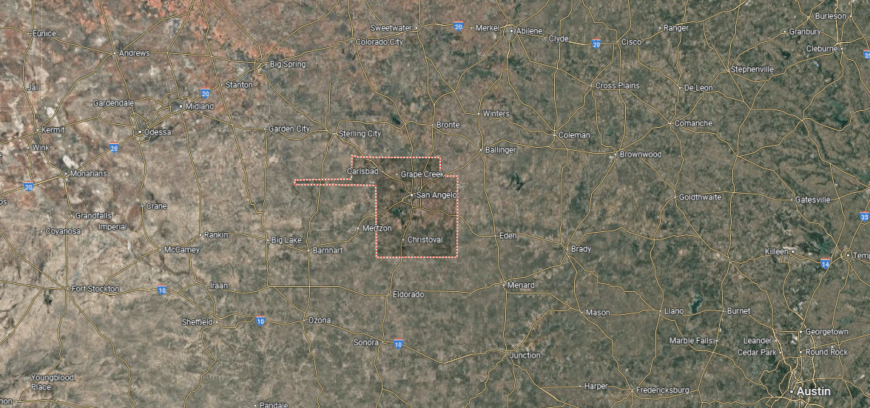
Tom Green County is located in west-central Texas, bordered by Coke County to the north, Concho County to the east, and Irion County to the west. It lies about 200 miles northwest of Austin and 225 miles southwest of Fort Worth. The county’s terrain is part of the Edwards Plateau, featuring rolling hills, open prairies, and the Concho River running through its center.
San Angelo, the county seat, is the largest city and serves as a regional hub for commerce, healthcare, and education. Smaller communities include Christoval to the south and Carlsbad to the north. With its mix of ranching traditions, military presence at Goodfellow Air Force Base, and river-centered recreation, Tom Green County blends west Texas heritage with modern growth.
#19. Hansford County, Texas
– Overall Rank: 233
– Population: 5,270
– Median household income: $62,350
– Median home value: $101,700 (75% own)
– Median rent: $823 (25% rent)
– Top public schools: Gruver Junior High School (grade A), Gruver Elementary School (grade A), Spearman Junior High School (grade A)
– Top private schools:
– Top places: Spearman (grade A minus), Gruver (grade A minus), Morse (grade B+)

About
Hansford County sits in the northern Texas Panhandle, where open prairies and farmland stretch toward the horizon. Spearman, the county seat, reflects the county’s frontier roots, built on farming, ranching, and the steady rhythms of small-town life. The wide plains and big skies remain a defining feature of its identity.
Civic pride is carried through school traditions, agricultural fairs, and community events that bring people together. Farming and ranching continue to anchor the local economy, with energy production adding another layer of growth. Hansford County represents a place where prairie land, history, and community ties remain firmly connected.
Where is Hansford County?
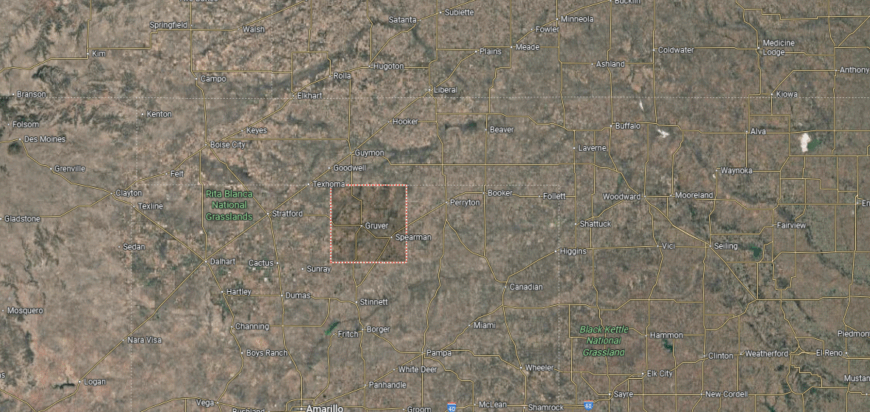
Hansford County is in the northern Texas Panhandle, bordered by Oklahoma to the north and Hutchinson County to the south. It lies about 100 miles north of Amarillo and covers part of the High Plains region, characterized by flat prairies and open farmland.
Spearman, the county seat, is located near the center and serves as the hub of local life. Gruver, another key community, lies to the southwest and adds to the county’s agricultural base. With its wide plains, farming traditions, and small-town communities, Hansford County reflects the rural character of the Panhandle.
#18. Somervell County, Texas
– Overall Rank: 224
– Population: 9,337
– Median household income: $87,899
– Median home value: $246,600 (82% own)
– Median rent: $853 (18% rent)
– Top public schools: Glen Rose Intermediate School (grade A), Glen Rose Junior High School (grade A minus), Glen Rose High School (grade A minus)
– Top private schools:
– Top places: Glen Rose (grade A minus)

About
Somervell County lies along the Paluxy River in North Central Texas, where limestone bluffs, wooded hills, and quiet valleys shape the land. Glen Rose, the county seat, is often called the “Dinosaur Capital of Texas,” known for its fossil tracks and rich natural history. The county’s small size gives it an intimate character, where heritage and landscape are closely linked.
Life along the river flows through outdoor recreation, cultural festivals, and historic sites that draw both locals and visitors. Economic life blends tourism, agriculture, and energy, reflecting the county’s balance of tradition and modern enterprise. Somervell County stands as a place where history, nature, and community spirit are deeply intertwined.
Where is Somervell County?
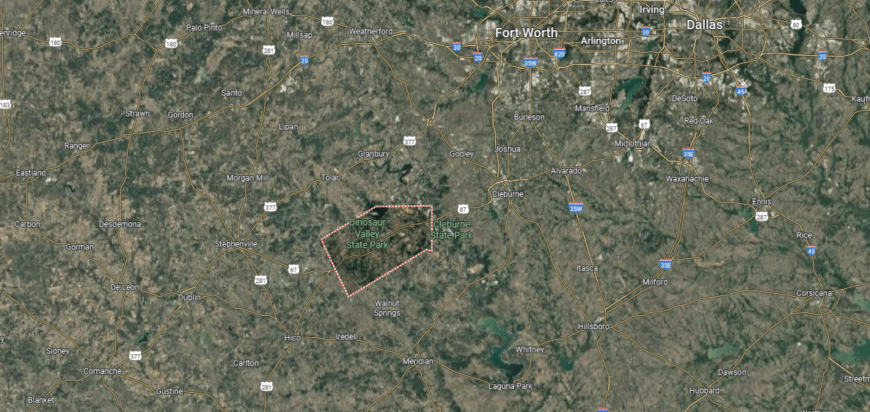
Somervell County is located in north-central Texas, bordered by Hood County to the north, Bosque County to the south, and Johnson County to the east. It lies about 50 miles southwest of Fort Worth and is the second-smallest county in Texas by land area. The county is part of the Cross Timbers region, with rolling hills, wooded areas, and the Paluxy River flowing through its center.
Glen Rose, the county seat, is positioned near the middle and serves as the cultural and civic hub. Smaller rural communities are scattered across the county, contributing to its close-knit character. Known for Dinosaur Valley State Park and Fossil Rim Wildlife Center, Somervell County combines natural attractions with small-town life.
#17. McLennan County, Texas
– Overall Rank: 217
– Population: 261,090
– Median household income: $59,781
– Median home value: $196,400 (60% own)
– Median rent: $1,048 (40% rent)
– Top public schools: Midway High School (grade A+), River Valley Middle School (grade A), South Bosque Elementary School (grade A)
– Top private schools: Vanguard College Preparatory School (grade A+), Live Oak Classical School (grade A), Bishop Louis Reicher Catholic School (grade A)
– Top places: Woodway (grade A+), Hewitt (grade A), Lorena (grade A minus)

About
McLennan County sits in Central Texas, with Waco as its county seat and regional anchor. Its identity is shaped by education, commerce, and culture, with Baylor University and a growing downtown adding to its role as a center of activity. Agriculture and industry remain important, balancing tradition with steady growth.
Community connections show through festivals, sports traditions, and civic gatherings that reflect both pride and diversity. Outdoor recreation along the Brazos River adds another dimension to daily life. McLennan County represents a place where heritage and modern development continue to work side by side.
Where is McLennan County?

McLennan County is in central Texas, bordered by Hill County to the north, Bell County to the south, and Bosque County to the west. It lies about 90 miles south of Dallas and 100 miles north of Austin, positioned along the Brazos River. The county’s geography blends Blackland Prairie farmland with rolling limestone hills.
Waco, the county seat, is the largest city and serves as a major hub for education, healthcare, and commerce. Smaller communities include Hewitt, Robinson, and McGregor, which form part of the county’s suburban network. With Baylor University, historic sites, and riverfront development, McLennan County balances cultural significance with regional growth.
#16. Burleson County, Texas
– Overall Rank: 213
– Population: 17,958
– Median household income: $71,745
– Median home value: $154,700 (79% own)
– Median rent: $977 (21% rent)
– Top public schools: Caldwell Middle School (grade A minus), Snook Elementary School (grade A minus), Caldwell Elementary School (grade B+)
– Top private schools: First Baptist School (grade unavailable)
– Top places: Caldwell (grade A minus), Snook (grade B+), Somerville (grade B+)
You may also like: The most popular poker players in Texas

About
Burleson County rests in the Brazos Valley, where prairies and farmland have long supported ranching and agriculture. Named after Edward Burleson, a leader of the Texas Revolution, the county carries deep ties to the state’s early history. Caldwell, the county seat, reflects this legacy through its courthouse square and strong small-town traditions.
Heritage is celebrated in festivals, local fairs, and community gatherings that bring people together across generations. Farming and ranching remain steady foundations, while proximity to larger cities provides new opportunities for growth. Burleson County stands as a place where history, land, and community pride remain firmly connected.
Where is Burleson County?
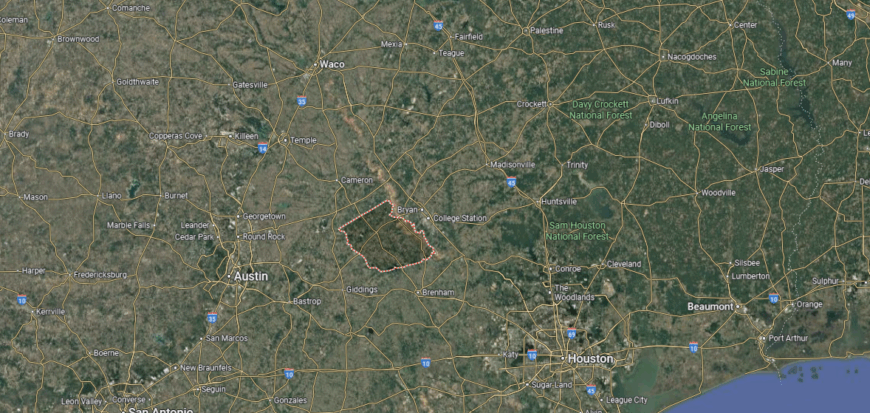
Burleson County is located in east-central Texas, bordered by Brazos County to the northeast, Lee County to the west, and Washington County to the south. It lies about 20 miles southwest of Bryan–College Station and roughly 90 miles northwest of Houston. The county sits within the Post Oak Savannah, with rolling prairies, woodlands, and the Brazos River forming much of its eastern boundary.
Caldwell, the county seat, is near the center and serves as the county’s main hub of government and commerce. Other communities include Somerville to the southeast, near Lake Somerville, and Snook closer to the Brazos Valley. With its agricultural roots, recreational lake access, and proximity to major cities, Burleson County offers a blend of rural life and regional connection.
#15. Taylor County, Texas
– Overall Rank: 208
– Population: 143,029
– Median household income: $61,806
– Median home value: $169,800 (59% own)
– Median rent: $1,063 (41% rent)
– Top public schools: Academy for Technology, Engineering, Math & Science (ATEMS) (grade A), Wylie East J.H. (grade A), Wylie West Elementary School (grade A)
– Top private schools: St. John’s Episcopal School (grade unavailable), Cornerstone Christian School (grade unavailable), A Habitat for Learning (grade unavailable)
– Top places: Potosi (grade A), Abilene (grade A minus), Tye (grade B)

About
Taylor County lies in West Texas, where rolling plains meet mesquite-dotted hills and open skies stretch wide across the land. Abilene, the county seat, anchors the region with its blend of military presence, higher education, and cultural institutions. The surrounding landscape, shaped by both ranching and settlement, gives the county a strong sense of place.
Daily life flows through school traditions, community festivals, and local arts that connect people to one another. Ranching and agriculture remain important, joined by commerce, healthcare, and education as drivers of growth. Taylor County reflects a place where Western heritage and modern opportunity share common ground.
Where is Taylor County?

Taylor County is in west-central Texas, bordered by Jones County to the north, Callahan County to the east, and Runnels County to the south. It lies about 180 miles west of Fort Worth and 150 miles southeast of Lubbock, positioned within the Rolling Plains region. The county’s terrain features open prairies, mesquite-covered hills, and the Clear Fork of the Brazos River.
Abilene, the county seat, is the largest city and a major regional hub for education, healthcare, and commerce. Smaller communities include Tuscola to the south and Merkel to the west, both tied to the county’s ranching and farming traditions. With its strong military presence at Dyess Air Force Base and central location in west Texas, Taylor County blends rural heritage with modern growth.
#14. Hays County, Texas
– Overall Rank: 195
– Population: 245,351
– Median household income: $79,990
– Median home value: $335,700 (63% own)
– Median rent: $1,355 (37% rent)
– Top public schools: Sycamore Springs Elementary School (grade A+), Sycamore Springs Middle School (grade A), Dripping Springs Elementary School (grade A)
– Top private schools: San Marcos Academy (grade A+), AESA Prep Academy (grade A), Hill Country Christian School of San Marcos (grade B)
– Top places: Dripping Springs (grade A), Buda (grade A minus), Wimberley (grade A minus)

About
Hays County sits in Central Texas, part of the fast-growing corridor between Austin and San Antonio. San Marcos, the county seat, is home to Texas State University and serves as both an educational and cultural hub. The county blends historic towns, agriculture, and rapid suburban growth.
Local life is marked by festivals, school traditions, and the spring-fed San Marcos River, which anchors recreation and community spirit. Growth in business, education, and tourism has added new opportunities while keeping ties to heritage intact. Hays County reflects a dynamic mix of tradition and modern development.
Where is Hays County?
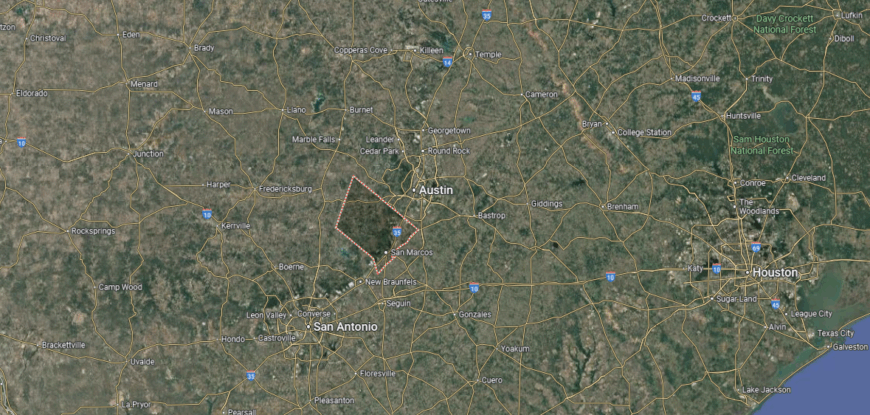
Hays County is in south-central Texas, bordered by Travis County to the northeast, Comal County to the south, and Blanco County to the west. It lies about 20 miles southwest of Austin and 60 miles northeast of San Antonio. The landscape transitions from the Edwards Plateau to the Blackland Prairie, with rolling hills, rivers, and limestone terrain.
San Marcos, the county seat, is located on the San Marcos River and is home to Texas State University. Kyle and Buda, two of the fastest-growing cities, are in the northern part of the county near Austin. Dripping Springs, in the northwest, highlights the county’s Hill Country character and natural attractions.
#13. Brazos County, Texas
– Overall Rank: 154
– Population: 234,548
– Median household income: $57,562
– Median home value: $260,800 (47% own)
– Median rent: $1,120 (53% rent)
– Top public schools: College Station High School (grade A+), Wellborn Middle (grade A+), A&M Consolidated High School (grade A+)
– Top private schools: Allen Academy (grade A+), Brazos Christian School (grade A), Brazos Valley Cornerstone Christian Academy (grade A)
– Top places: College Station (grade A), Bryan (grade A minus), Wixon Valley (grade B+)

About
Brazos County lies in the Brazos Valley of East-Central Texas, where fertile land and historic trade routes shaped its early growth. Bryan, the county seat, and College Station together form a hub of culture, education, and commerce. The presence of Texas A&M University has transformed the county into a center of learning and innovation while keeping its agricultural roots visible.
Community pride is expressed in university traditions, local festivals, and gatherings that celebrate both heritage and progress. Agriculture and ranching remain part of the landscape, joined by education and technology as drivers of the local economy. Brazos County reflects a place where history, growth, and community remain closely tied.
Where is Brazos County?

Brazos County is in east-central Texas, bordered by Robertson County to the north, Burleson County to the west, and Grimes County to the south. It lies about 100 miles northwest of Houston and 90 miles east of Austin. The Brazos River forms much of its western boundary, shaping the county’s fertile landscape.
Bryan, the county seat, sits near the center and shares a close connection with College Station to the south. College Station is home to Texas A&M University, making it the cultural and economic driver of the region. With its blend of education, research, and agriculture, Brazos County anchors the Brazos Valley.
#12. Montgomery County, Texas
– Overall Rank: 139
– Population: 629,989
– Median household income: $95,946
– Median home value: $293,500 (73% own)
– Median rent: $1,416 (27% rent)
– Top public schools: The Woodlands High School (grade A+), College Park High School (grade A+), Sam Houston State University Charter School (grade A+)
– Top private schools: The John Cooper School (grade A+), The Woodlands Christian Academy (grade A+), Esprit International School (grade A)
– Top places: The Woodlands (grade A+), Oak Ridge North (grade A+), Conroe (grade A minus)

About
Montgomery County rests in Southeast Texas, where pine forests, lakes, and rolling terrain shape both scenery and settlement. Once rooted in timber and farming, the county has become one of the fastest-growing in the state, blending rural landscapes with suburban expansion. Conroe, the county seat, anchors a region that balances natural beauty with modern growth.
Life here is enriched by Lake Conroe, forest trails, and community festivals that draw residents together. A strong economy, fueled by commerce, energy, and proximity to Houston, continues to bring new opportunities. Montgomery County reflects a place where wooded landscapes and rapid development exist side by side.
Where is Montgomery County?

Montgomery County is in southeastern Texas, bordered by Walker County to the north, Harris County to the south, and Liberty County to the east. It lies about 40 miles north of Houston and is part of the greater Houston metropolitan area. The terrain includes pine forests, rolling prairies, and the San Jacinto River basin.
Conroe, the county seat, is located near the center and has grown into a major suburban hub. Other communities include The Woodlands, a large master-planned community, and Montgomery, known as the “Birthplace of the Texas Flag.” With its rapid growth, lake access, and suburban development, Montgomery County blends natural landscapes with modern expansion.
#11. Brewster County, Texas
– Overall Rank: 127
– Population: 9,454
– Median household income: $47,747
– Median home value: $200,500 (60% own)
– Median rent: $780 (40% rent)
– Top public schools: Alpine Middle School (grade B+), Alpine High School (grade B+), Alpine Elementary School (grade B minus)
– Top private schools: Alpine Christian School (grade unavailable), Alpine Montessori School (grade unavailable)
– Top places: Alpine (grade A), Marathon (grade B+), Study Butte (grade unavailable)
You may also like: Texas small businesses thrive in these counties

About
Brewster County stretches across the Big Bend region, the largest county in Texas by land area yet among the most sparsely populated. Its vast deserts, canyons, and mountains form a dramatic landscape that defines both history and identity. Alpine, the county seat, provides a cultural anchor amid the sweeping isolation of the Trans-Pecos.
Life here follows the rhythms of land and sky—border heritage, outdoor traditions, and community events tie people together across wide distances. Tourism, ranching, and education form the core of the economy, with Big Bend National Park drawing visitors from around the world. Brewster County stands as a place where rugged beauty, resilience, and frontier spirit remain inseparable.
Where is Brewster County?
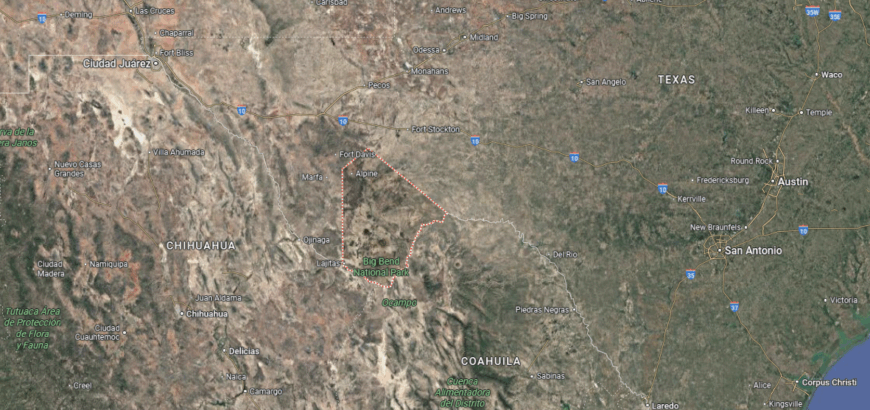
Brewster County is in far west Texas, bordered by Presidio County to the west, Terrell County to the east, and Mexico to the south along the Rio Grande. It is the largest county in Texas by land area, covering over 6,100 square miles. The terrain includes desert basins, rugged mountains, and sections of Big Bend National Park.
Alpine, the county seat, lies in the northern part of the county and serves as the primary hub of commerce and education. Smaller communities include Marathon to the northeast and Study Butte–Terlingua near the Big Bend area. With its vast open spaces, international border, and striking natural landmarks, Brewster County stands out as one of Texas’s most scenic and remote regions.
#10. Randall County, Texas
– Overall Rank: 120
– Population: 141,489
– Median household income: $78,038
– Median home value: $209,200 (69% own)
– Median rent: $1,072 (31% rent)
– Top public schools: Hillside Elementary School (grade A), Reeves-Hinger Elementary School (grade A), Canyon Junior High School (grade A)
– Top private schools: Ascension Academy (grade A+), Holy Cross Catholic Academy (grade A minus), St. Joseph Catholic Elementary School (grade unavailable)
– Top places: Canyon (grade A+), Timbercreek Canyon (grade A), Lake Tanglewood (grade B+)

About
Randall County lies in the Texas Panhandle, anchored by Canyon as its county seat and closely tied to the neighboring city of Amarillo. Its history is rooted in ranching and settlement across the High Plains, while today it serves as both an agricultural center and a suburban extension of a growing metro area. West Texas A&M University in Canyon adds a strong educational and cultural presence.
Civic life is carried by school traditions, university events, and community gatherings that highlight both heritage and progress. Agriculture and ranching remain important foundations, joined by education and commerce as drivers of growth. Randall County reflects a blend of High Plains heritage and modern regional identity.
Where is Randall County?

Randall County is in the Texas Panhandle, bordered by Armstrong County to the east, Deaf Smith County to the west, and Potter County to the north. It lies about 15 miles south of Amarillo and is part of the High Plains region. The county’s landscape features flat prairies, canyons, and stretches of the Prairie Dog Town Fork of the Red River.
Canyon, the county seat, is located near the center and is home to West Texas A&M University. Amarillo also extends into the northern part of Randall County, providing urban connections. With Palo Duro Canyon State Park nearby, Randall County blends educational, cultural, and natural attractions.
#9. Comal County, Texas
– Overall Rank: 111
– Population: 165,201
– Median household income: $93,744
– Median home value: $369,400 (76% own)
– Median rent: $1,390 (24% rent)
– Top public schools: Rahe Bulverde Elementary School (grade A), Hoffmann Lane Elementary School (grade A), Smithson Valley Middle School (grade A)
– Top private schools: St. John Paul II Catholic High School (grade A), Living Rock Academy (grade A), New Braunfels Christian Academy (grade A minus)
– Top places: Fair Oaks Ranch (grade A), Garden Ridge (grade A), New Braunfels (grade A)

About
Comal County rests in the Texas Hill Country, where clear rivers, limestone bluffs, and rolling hills shape both scenery and tradition. New Braunfels, the county seat, reflects a strong German heritage visible in its festivals, architecture, and community life. The Guadalupe and Comal Rivers provide both a natural anchor and a steady draw for visitors.
Local rhythms include river recreation, cultural celebrations like Wurstfest, and gatherings in historic town squares. Growth in tourism, commerce, and suburban development blends with deep-rooted ties to land and heritage. Comal County stands as a place where natural beauty and cultural tradition flow together.
Where is Comal County?
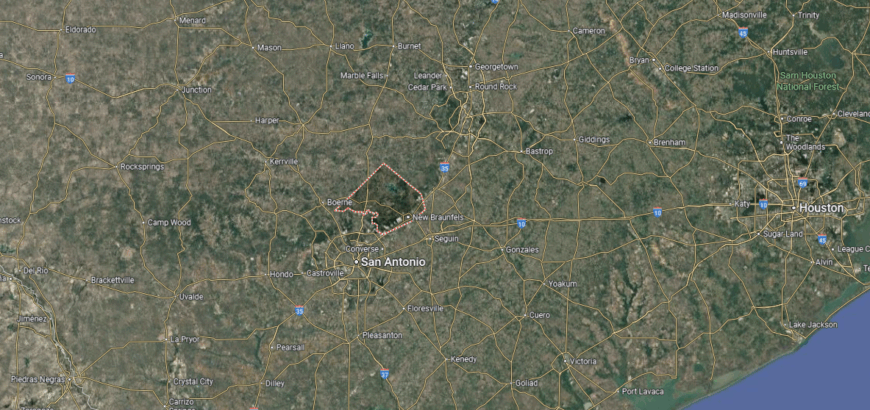
Comal County is in south-central Texas, bordered by Hays County to the north, Bexar County to the south, and Guadalupe County to the east. It lies about 30 miles northeast of San Antonio and 45 miles southwest of Austin, situated in the heart of the Hill Country. The county’s geography includes limestone hills, spring-fed rivers, and scenic valleys.
New Braunfels, the county seat, is located along the Comal and Guadalupe Rivers and is known for its German heritage. Other communities include Bulverde to the north and Garden Ridge near the southern edge. With its rapid growth, river recreation, and cultural traditions, Comal County blends Hill Country charm with modern suburban development.
#8. Lubbock County, Texas
– Overall Rank: 97
– Population: 311,509
– Median household income: $61,911
– Median home value: $183,700 (56% own)
– Median rent: $1,087 (44% rent)
– Top public schools: Crestview Elementary School (grade A+), Talkington School for Young Women Leaders (grade A+), Bennett Elementary School (grade A+)
– Top private schools: All Saints Episcopal School (grade A+), Christ the King Diocesan Schools (grade A+), Lubbock Christian School (grade A)
– Top places: Wolfforth (grade A), Lubbock (grade A), Shallowater (grade A minus)

About
Lubbock County lies on the South Plains of West Texas, with the city of Lubbock as its county seat and regional hub. Its identity is shaped by agriculture, higher education, and a growing role in healthcare and commerce. Texas Tech University anchors much of the county’s cultural and economic life.
Community connections show in university traditions, school events, and civic festivals that highlight both heritage and progress. Cotton farming remains central, joined by industry and research as drivers of development. Lubbock County reflects a balance of prairie heritage and modern opportunity.
Where is Lubbock County?

Lubbock County is in the northwestern part of Texas, bordered by Hale County to the north, Lynn County to the south, and Crosby County to the east. It lies about 120 miles south of Amarillo and is part of the High Plains region. The county’s landscape is dominated by flat prairies and farmland within the Llano Estacado.
Lubbock, the county seat, is the largest city and serves as a major hub for education, healthcare, and commerce. Smaller communities include Shallowater to the northwest and Slaton to the southeast. With Texas Tech University and its strong agricultural base, Lubbock County anchors the economy and culture of the South Plains.
#7. Kendall County, Texas
– Overall Rank: 93
– Population: 45,376
– Median household income: $104,196
– Median home value: $464,100 (76% own)
– Median rent: $1,455 (24% rent)
– Top public schools: Voss Middle School (grade A), Herff Elementary School (grade A), Boerne-Samuel V. Champion High School (grade A)
– Top private schools: Geneva School of Boerne (grade A+), Crestmont Christian Preparatory School (grade A), Hill Country Montessori School (grade unavailable)
– Top places: Boerne (grade A), Comfort (grade B minus)

About
Kendall County rests in the Texas Hill Country, where limestone hills and clear streams shaped early settlement. Its history reflects strong German influence, especially in Boerne, the county seat, where traditions of architecture, music, and community gatherings remain visible. Farming and ranching gave the county its foundation, while heritage and culture continue to define its identity.
Festivals, historic districts, and local fairs preserve the sense of continuity that links present to past. Growth in tourism and suburban development has added new energy, but the county maintains deep ties to its cultural roots. Kendall County represents a place where heritage, landscape, and modern life are woven together.
Where is Kendall County?
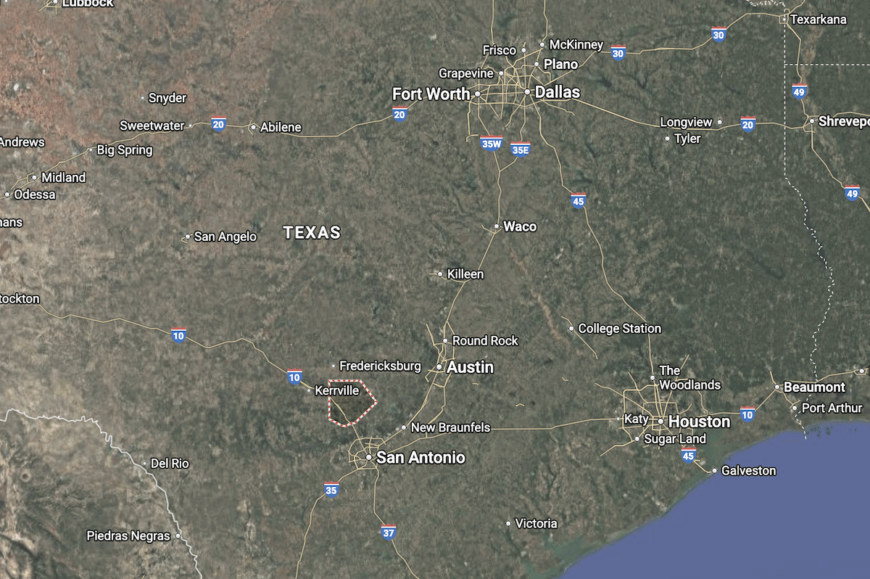
Kendall County is located in south-central Texas, bordered by Gillespie County to the west, Comal County to the south, and Blanco County to the north. It lies about 30 miles northwest of San Antonio and sits in the rolling terrain of the Hill Country. The Guadalupe River crosses the county, adding to its scenic character.
Boerne, the county seat, is near the center and has become a growing suburban hub connected to San Antonio. Smaller communities include Comfort to the west and Fair Oaks Ranch along the southern edge. With its blend of Hill Country landscapes, historic towns, and rapid development, Kendall County reflects both rural charm and modern growth.
#6. Williamson County, Texas
– Overall Rank: 57
– Population: 617,396
– Median household income: $102,851
– Median home value: $370,100 (68% own)
– Median rent: $1,597 (32% rent)
– Top public schools: Westwood High IB World School (grade A+), Meridian World School (grade A+), Round Rock High School (grade A+)
– Top private schools: Hill Country Christian School of Austin (grade A+), Round Rock Christian Academy (grade A), St. Dominic Savio Catholic High School (grade A)
– Top places: Brushy Creek (grade A+), Cedar Park (grade A+), Leander (grade A+)
You may also like: Counties with the most homes selling under list price in Texas

About
Williamson County lies in Central Texas, where prairie grasslands meet the limestone ridges of the Hill Country. Its towns—Georgetown, Round Rock, and others—reflect both deep historic roots and the rapid growth of the Austin metropolitan area. The San Gabriel River and wide open spaces give the county a landscape that connects tradition with change.
Life unfolds in courthouse squares, riverfront parks, and festivals that celebrate community pride. Agriculture and ranching remain visible, even as technology, education, and commerce drive modern growth. Williamson County represents a place where natural setting and swift development move together in balance.
Where is Williamson County?

Williamson County is in central Texas, bordered by Bell County to the north, Travis County to the south, and Burnet County to the west. It lies about 25 miles north of Austin and forms part of the rapidly growing Austin metropolitan area. The landscape includes Blackland Prairie in the east and the rocky hills of the Edwards Plateau in the west.
Georgetown, the county seat, is located near the center along the San Gabriel River. Other major communities include Round Rock, Cedar Park, and Leander, all of which have seen significant suburban expansion. With its mix of historic towns, fast-growing suburbs, and natural features, Williamson County is one of the state’s most dynamic regions.
#5. Travis County, Texas
– Overall Rank: 36
– Population: 1,289,054
– Median household income: $92,731
– Median home value: $444,800 (53% own)
– Median rent: $1,561 (47% rent)
– Top public schools: Liberal Arts & Science Academy (grade A+), Westlake High School (grade A+), Vandegrift High School (grade A+)
– Top private schools: St. Stephen’s Episcopal School (grade A+), Austin Peace Academy (grade A+), St. Andrew’s Episcopal School (grade A+)
– Top places: Triangle State (grade A+), Downtown (grade A+), Hyde Park (grade A+)

About
Travis County anchors Central Texas with Austin as its county seat and state capital. Its identity is shaped by government, higher education, technology, and a thriving cultural scene that extends far beyond the region. Rapid growth has made it one of the most dynamic counties in Texas.
Civic life thrives through music festivals, university traditions, and community events that highlight both diversity and innovation. The Colorado River and surrounding Hill Country provide a natural backdrop that balances urban expansion. Travis County reflects a place where culture, commerce, and community intersect on a global scale.
Where is Travis County?
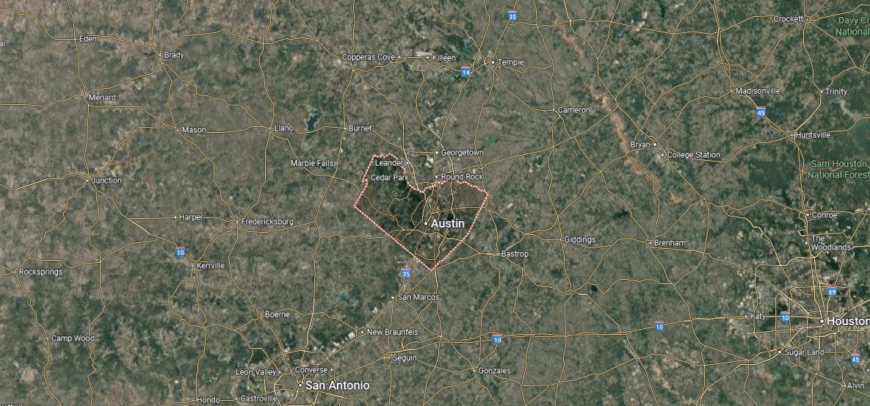
Travis County is in south-central Texas, bordered by Williamson County to the north, Hays County to the south, and Bastrop County to the east. It lies in the Texas Hill Country, about 80 miles northeast of San Antonio, with terrain that ranges from limestone hills in the west to Blackland Prairie in the east. The Colorado River runs through the county, forming lakes and reservoirs that shape the local landscape.
Austin, the county seat, is also the state capital and serves as a major hub for government, technology, culture, and education. Surrounding communities include Pflugerville to the north, Lakeway to the west, and Manor to the east. With its combination of rapid urban growth, natural scenery, and cultural vibrancy, Travis County anchors central Texas.
#4. Rockwall County, Texas
– Overall Rank: 34
– Population: 110,631
– Median household income: $121,303
– Median home value: $363,500 (83% own)
– Median rent: $1,779 (17% rent)
– Top public schools: Rockwall-Heath High School (grade A)
– Top private schools: Heritage Christian Academy (grade A), The Fulton School (grade unavailable), Providence Academy (grade unavailable)
– Top places: Heath (grade A+), Rockwall (grade A+), Fate (grade A)

About
Rockwall County, the smallest by land area in Texas, sits along the eastern edge of the Dallas–Fort Worth metroplex. Its name comes from a mysterious underground rock wall formation discovered by early settlers, a feature that remains part of local lore. Rockwall, the county seat, has grown from an agricultural community into a vibrant suburban hub.
Traditions are preserved through historic districts, festivals, and civic events that tie new growth to older roots. While commerce and suburban development now shape much of its identity, the county maintains pride in its history and small size. Rockwall County reflects a place where legend, heritage, and modern life meet.
Where is Rockwall County?
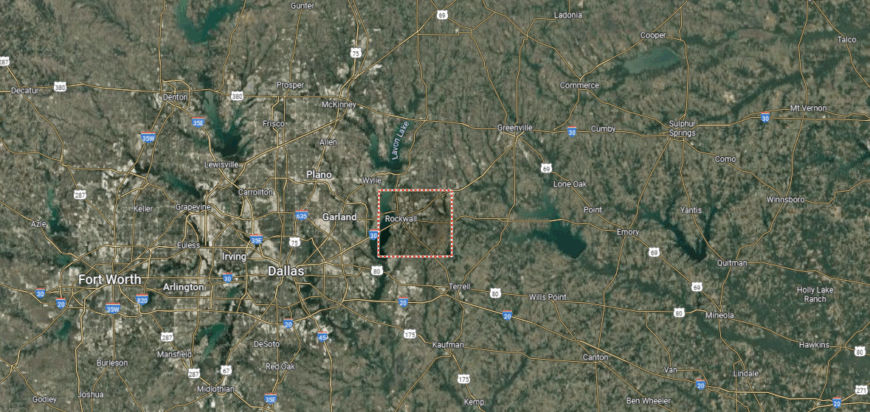
Rockwall County is in northeastern Texas, bordered by Collin County to the north, Kaufman County to the south, and Dallas County to the west. It is the smallest county in Texas by land area, covering just under 150 square miles. The county lies along the eastern shore of Lake Ray Hubbard, giving it both suburban development and recreational waterfront.
Rockwall, the county seat, is located near the lake and serves as the central hub for government and commerce. Other communities include Royse City to the northeast and Fate to the east, both part of the Dallas–Fort Worth metropolitan area. With its rapid suburban growth, proximity to Dallas, and access to lakefront amenities, Rockwall County blends small size with significant regional impact.
#3. Denton County, Texas
– Overall Rank: 33
– Population: 914,870
– Median household income: $104,180
– Median home value: $377,000 (65% own)
– Median rent: $1,496 (35% rent)
– Top public schools: Flower Mound High School (grade A+), Reedy High School (grade A+), Wakeland High School (grade A+)
– Top private schools: The Clariden School (grade A+), Liberty Christian School (grade A+), Selwyn School (grade A)
– Top places: Flower Mound (grade A+), Trophy Club (grade A+), Highland Village (grade A+)

About
Denton County stretches across the rolling prairies and wooded creeks of North Texas, where open land now blends with the energy of a growing metro region. Denton, the county seat, is known for its universities, music culture, and historic courthouse square that anchors the community’s spirit. The mix of prairie openness and urban expansion gives the county a character both rooted and forward-looking.
Gatherings take shape in festivals, concerts, and school traditions that highlight its creative and diverse identity. Ranching and farming still leave their mark, even as education, technology, and commerce drive new growth. Denton County reflects a place where landscape, culture, and modern life come together in balance.
Where is Denton County?
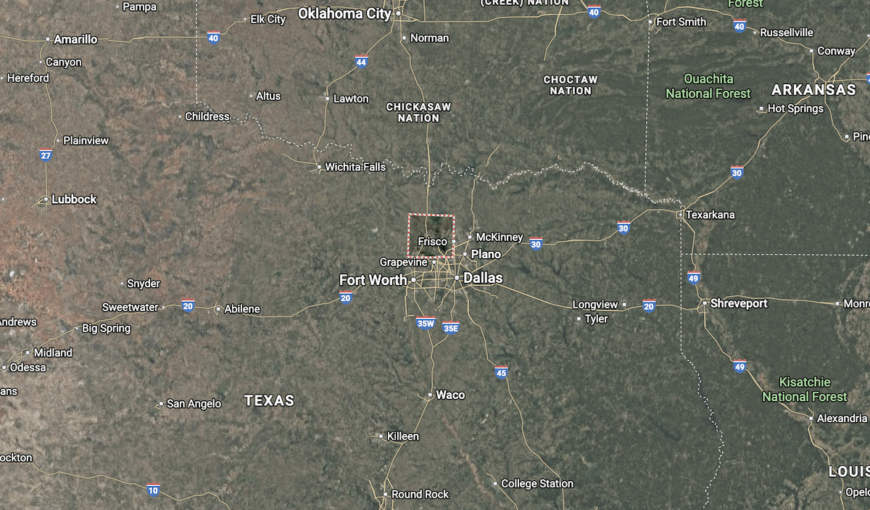
Denton County is in north-central Texas, bordered by Cooke County to the north, Collin County to the east, and Tarrant County to the south. It lies about 40 miles northwest of Dallas and 35 miles north of Fort Worth, positioned within the Dallas–Fort Worth metroplex. The county’s geography includes prairie lands, rolling hills, and major reservoirs such as Lewisville Lake and Lake Ray Roberts.
Denton, the county seat, is home to the University of North Texas and Texas Woman’s University, making it an educational hub. Other large communities include Lewisville, Flower Mound, and The Colony, all part of the metroplex’s suburban network. With its combination of higher education, suburban growth, and recreational lakes, Denton County is one of the fastest-growing regions in Texas.
#2. Fort Bend County, Texas
– Overall Rank: 15
– Population: 832,607
– Median household income: $109,987
– Median home value: $329,600 (78% own)
– Median rent: $1,669 (22% rent)
– Top public schools: Seven Lakes High School (grade A+), Obra D. Tompkins High School (grade A+), Clements High School (grade A+)
– Top private schools: Fort Bend Christian Academy (grade A+), Logos Preparatory Academy (grade A), Calvary Episcopal Preparatory (grade A)
– Top places: Cinco Ranch (grade A+), Sugar Land (grade A+), New Territory (grade A+)

About
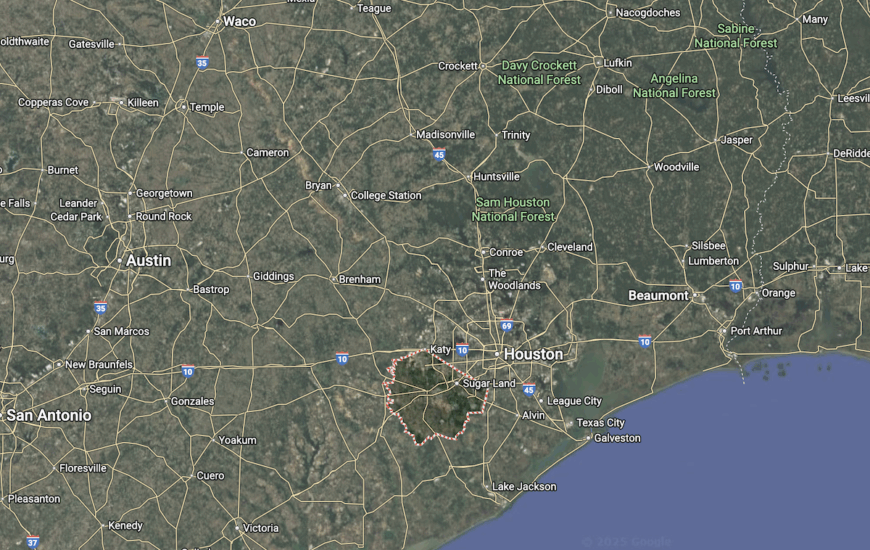
Fort Bend County lies just southwest of Houston, one of the fastest-growing regions in Texas. Sugar Land, Richmond, and other communities reflect both suburban expansion and a diverse cultural identity. The county’s history as a farming and ranching area remains visible even as it has become a hub for commerce, healthcare, and education.
Local life thrives through cultural festivals, school events, and civic gatherings that showcase community pride. Parks, rivers, and historic sites provide balance to rapid development and urban influence. Fort Bend County represents a blend of heritage, diversity, and modern growth.
Where is Fort Bend County?
Fort Bend County is located in southeastern Texas, bordered by Harris County to the northeast, Brazoria County to the southeast, and Waller County to the northwest. It lies about 25 miles southwest of downtown Houston and is part of the Houston metropolitan area. The county’s terrain includes flat coastal plains, the Brazos River, and areas of prairie and bottomland.
Richmond, the county seat, sits near the center along the Brazos River, while nearby Rosenberg has grown into a regional commercial hub. Larger suburban communities include Sugar Land, Missouri City, and Katy, all tied to Houston’s expansion. With its rapid population growth, diverse communities, and strong economy, Fort Bend County is among the fastest-developing areas in Texas.
#1. Collin County, Texas
– Overall Rank: 4
– Population: 1,079,153
– Median household income: $113,255
– Median home value: $411,100 (65% own)
– Median rent: $1,689 (35% rent)
– Top public schools: Liberty High School (grade A+), Plano East Senior High School (grade A+), Jasper High School (grade A+)
– Top private schools: John Paul II High School (grade A+), Prince of Peace Christian School (grade A+), Spring Creek Academy (grade A)
– Top places: Timberbrook (grade A+), Preston Highlands (grade A+), Frisco (grade A+)
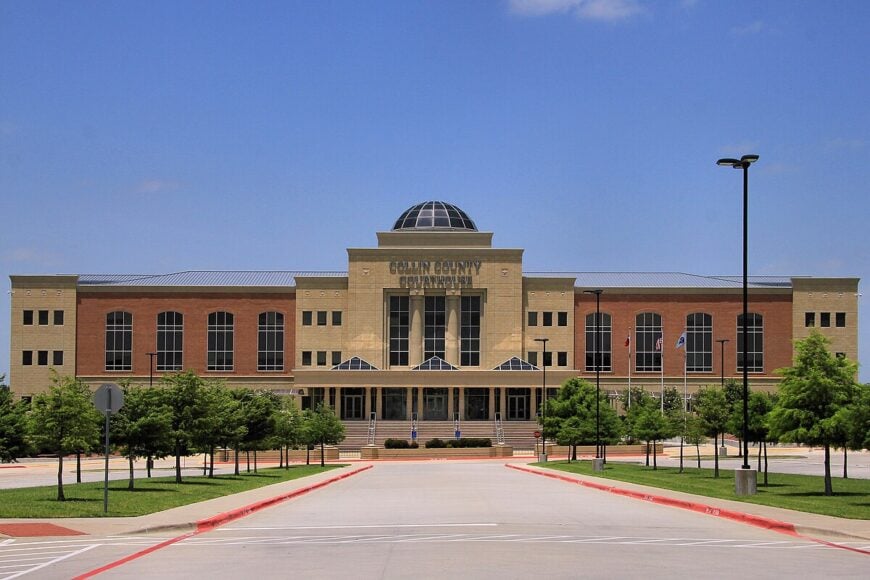
About
Collin County sits in North Texas, once a land of prairies and farms that supported early frontier settlements. McKinney, the county seat, preserves this history with its courthouse square, historic districts, and traditions that reflect a deep connection to the past. Over time, the county has transformed into one of the fastest-growing suburban regions of the Dallas–Fort Worth metroplex.
Heritage is honored through festivals, museums, and community gatherings that keep historic roots visible amid modern expansion. Agriculture and ranching still hold a place, though commerce, technology, and education now shape much of the county’s growth. Collin County reflects a place where frontier legacy and modern development remain closely tied.
Where is Collin County?
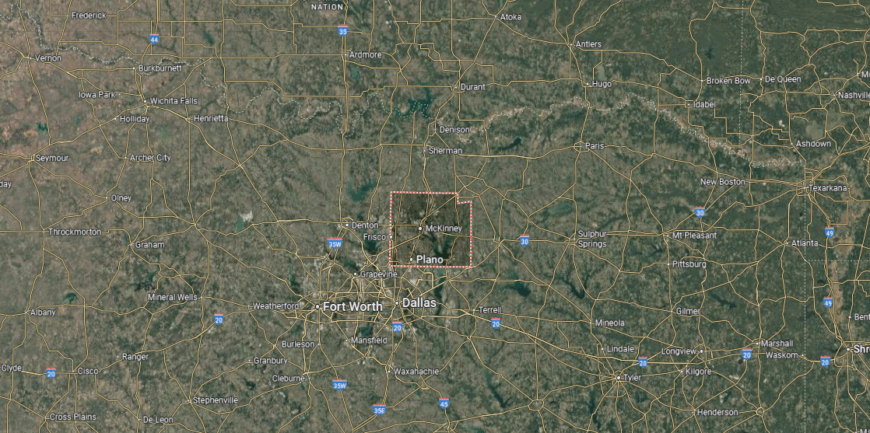
Collin County is in north-central Texas, bordered by Grayson County to the north, Denton County to the west, and Dallas County to the south. It lies about 25 miles north of downtown Dallas and is part of the Dallas–Fort Worth metropolitan area. The county’s landscape consists of Blackland Prairie, rolling hills, and sections of the East Fork of the Trinity River.
McKinney, the county seat, is one of the fastest-growing cities in the nation and serves as a major hub for commerce and government. Other large communities include Plano, Frisco, and Allen, all of which have become key suburban and business centers. With rapid suburban expansion, strong economic development, and proximity to Dallas, Collin County is one of the most dynamic counties in Texas.
This story features data reporting and writing by Elena Cox and is part of a series utilizing data automation across 50 states.
You may also like: The top patent earner in Texas last year
By Stacker






